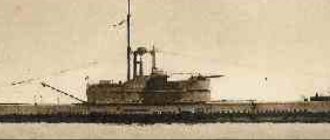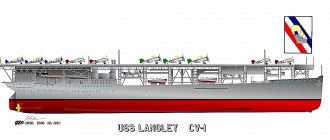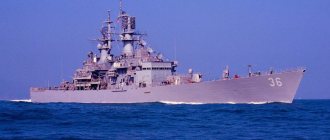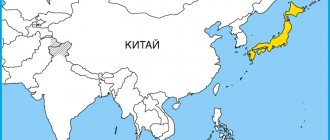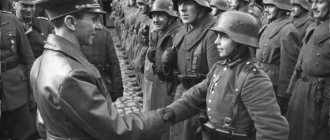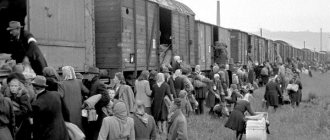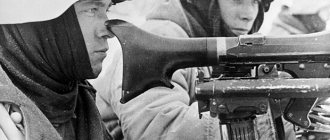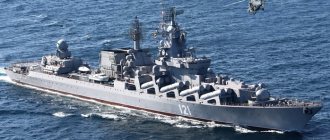Black Summer of '41: The Baltic Fleet goes into battle
The summer of 1941 became a dark period in the history of the Red Banner Baltic Fleet. It turned out that the Soviet sailors were not ready for war, much less ready to act in the conditions in which the enemy placed them. The main enemy of the Baltic Fleet turned out to be not enemy surface ships, but Luftwaffe aircraft, which had firmly seized air supremacy, and German ground forces, which were step by step occupying naval bases.
Baltic 1941: forces and plans of the German Navy
Having analyzed the experience of the First World War, the Kriegsmarine command concentrated the bulk of its mine forces in the Baltic. By June 1941, there were 10 large high-speed minelayers with a displacement of 2000–3000 tons and a speed of 17–20 knots; the largest of them, Preussen, had a capacity of 5504 brt.
In addition, subordinate to the naval structures allocated for operations in the East (the headquarters of the commander of the cruisers, Admiral Schmundt, and the headquarters of the chief of the destroyers, Rear Admiral Byutov), were: part of the 22nd submarine flotilla - 5 submarines, five torpedo boat flotillas (1st, 2nd, 3rd, 5th and 6th) - 30 boats and 4 floating bases, 5th flotilla of specially built high-speed minesweepers - 6 ships of the M-35 type, four flotillas of auxiliary minesweepers from mobilized ships (15th , 17th, 18th and 31st) - a total of 28 ships, the 5th flotilla of motor minesweepers - 10 "raumbots". In addition, there was the 11th flotilla of submarine hunters (8 units) and the 3rd flotilla of escort ships (11 units).
The main striking force of the Kriegsmarine in the Baltic were torpedo boats: more than half of the combat-ready ships of this class were assembled here. Their relatively large displacement (up to hundreds of tons), long range and good seaworthiness allowed them to attack Soviet convoys even in the Gulf of Finland.
The deployment of the Soviet, German and Finnish fleets before the start of the war (according to Soviet data). Chronicle of the Great Patriotic War of the Soviet Union on the Baltic Sea and Lake Ladoga. Issue 1, 1945
But the allocated number of minesweepers turned out to be clearly insufficient. These ships operated with great effort (including as escort ships), as a result, during three months of operations in the Gulf of Riga, seven auxiliary and motor minesweepers were killed, three of them in July. In addition, only in July, two high-speed and two motor minesweepers were damaged and had to undergo repairs for a long time. Therefore, already in July, the 1st flotilla of minesweepers (seven units) was transferred from France to Memel, and the transfer of the 2nd flotilla of motor minesweepers began (34 “raumboats” were transferred until November). In addition, from August to November, a new 4th minesweeper flotilla was formed in the Baltic. If the Germans had somewhere to take ships from, closing the “holes” that arose, then the command of the Soviet fleet did not have such an opportunity.
A huge role in the subsequent actions of the Germans was played by specially built landing craft: lighters, self-propelled ferries and assault boats. These ships belonged to all three branches of the military (Navy, Air Force and Ground Forces), the bulk of them were assembled into the “Experimental Baltic Sea Force”. By mid-September, there were 4 landing transports, 12 high-speed landing barges, a large number of mobilized coasters, tugs, barges and boats, as well as five floating batteries (gunboats) for fire support. Finally, the 128th Engineer Battalion, which had 26 Siebel-type ferries, was placed at the disposal of the naval command. Landing craft were actively used for maritime transport, and later (in September and October) during landings on the islands of the Moonsund archipelago.
Small motor minesweeper (“raumboat”) of the F-130 series. Die Deutsche Kriegsmarine 1935–1945. Band 2. Podzun-Palas Verlag 1994
All of the listed minesweepers, raumboats, lighters and barges were small ships, but their overall value should not be underestimated: only for specially built ships (from a minesweeper and smaller) the total displacement reached 17,000 tons, that is, corresponding to a dozen modern destroyers.
Capabilities of the Soviet Baltic Fleet: myths and reality
The Red Banner Baltic Fleet (KBF) had only 12 high-speed squadron minesweepers capable of accompanying large warships on a voyage. There were also not enough low-speed minesweepers, despite the mobilization of civilian ships carried out during the Finnish War, there were only 20 of them (together with boat minesweepers). During the war, the mobilization continued, but now there were not enough weapons or trained crews for the new minesweepers; in addition, the bulk of the small vessels to be mobilized had a speed of 5–6 knots and were completely unsuited for combat service.
In addition, an acute shortage of patrol, escort and auxiliary ships suitable for a variety of “secondary” work has emerged, without which neither the maintenance of sea communications nor the full-fledged combat activity of the fleet is possible. There was a particular shortage of fast ships of this class. The Hurricane-class destroyers created back in the late 20s (in the Soviet Union they were considered patrol boats) were immediately criticized for the fact that they were not full-fledged destroyers and could only provide 25 knots of speed instead of the designed 30. “The ships are neither no way"
, - said the head of the Naval Forces I.K. about them in 1937. Kozhanov. As a result of these small, cheap and versatile ships, only 18 were built, of which there were seven in the Baltic - fewer than destroyers. In addition, six patrol ships from the border guard were transferred to the Red Banner Baltic Fleet. As a result, the high-speed patrol boats of the “bad weather division” were used extremely intensively, and instead of them, destroyers had to be used every now and then, the losses of which turned out to be much more sensitive.
The patrol ship of the Baltic Fleet "Whirlwind", the same type as the "Cloud" and "Snow". View from 1940. Marine collection", 2005, No. 5
The Red Banner Baltic Fleet had a sufficient number of combat boats: 67 torpedo boats and 98 patrol boats (including armored boats). Other problems arose with them: planing torpedo boats of the G-5 type with a displacement of only 17 tons had low seaworthiness, and their trough stern torpedo tubes, which dropped the torpedo into the water tail first, did not provide sufficient aiming accuracy. Fascinated by the high speed of such boats, Soviet sailors forgot about other qualities necessary for their full use.
“Small hunters” of the MO-4 type were cheap, fast, seaworthy and versatile. The main drawback of these combat units was the low rate of fire of the 45 mm cannons: although considered semi-automatic, they could not fire in bursts, and their effectiveness when firing at fast-moving targets (airplanes and boats) was insufficient. At the same time, German small ships and boats (including torpedo boats) were armed with more effective machine guns with a caliber of 20 to 37 mm, which had much greater firepower. Alas, the pre-war industry was unable to master the mass production of automatic guns on the same scale on which the Germans produced them.
This leads to an unexpected conclusion: in terms of small surface ships (up to and including the minesweeper), the German fleet in the Baltic, even without taking into account the Finns, by the beginning of the war was noticeably superior to the Soviet naval forces. The Germans had more minesweepers and small craft suitable for patrol and escort service, especially if you take into account landing craft. In terms of total displacement, 67 Soviet torpedo boats were approximately three times inferior to 30 German Schnellboats.
At the beginning of the war, the Red Banner Baltic Fleet had only two gunboats in the Baltic Sea, converted from soil-carrying scows, and the Germans had 5 floating batteries with similar weapons, also converted from civilian ships. The Kriegsmarine's floating bases for torpedo boats and minesweepers were also serious warships, some of them were built specifically for the fleet and carried 105 mm artillery.
Torpedo boat S-35 type S-26 from the 3rd Schnellbot flotilla. In the summer of 1941, boats of this type and in the same coloring operated in the Baltic. Marine Collection, 1999, No. 2
Thus, for operations in the coastal zone from Libau to the mouth of the Gulf of Finland, the enemy had much more opportunities than the Soviet fleet. This was especially true of the Gulf of Riga, on the mainland coast of which, from the beginning of July to the end of August 1941, there was a front line that gradually shifted to the north. In such conditions, there was only one way to achieve an advantage - by throwing destroyers into the balance.
Finally, we should not forget about another important problem of the Soviet fleet - the acute shortage of trained personnel, primarily command personnel. In the three pre-war years, the number of personnel in the Baltic Fleet alone more than doubled - from 60,000 to 158,000 people. New ships entered service, new equipment appeared in the fleet and in the coastal service. It was impossible to prepare the required number of command personnel in the same time. The problem lay not even in the technical training of young naval officers - things were more or less normal with it. The head of naval educational institutions noted that school graduates have “quite satisfactory”
knowledge in their specialties, but do not know how to
“command and manage”
.
Command experience, like maritime practice, could only be gained with time, which the Soviet fleet did not have. Suffice it to say that of the two modern cruisers that were part of the Red Banner Baltic Fleet at the beginning of the war, only one was listed in the “first line”, and the second went through the so-called “organizational period”, that is, it was engaged in training personnel and mastering equipment. Of the 19 destroyers and leaders, five were in the “organization period”. The bulk of the minesweepers were also in the “organization period”. Most of the submarines were considered combat-ready, but only in the second line - their training was considered insufficient.
Mine war and first losses
Back in 1937, the chief of staff of the Red Banner Baltic Fleet, future admiral I.S. Isakov warned that “super-battleships and large submarines are absolutely not needed for a war against us.”
, and that in order to ensure its communications in the Baltic,
“the German fleet... will strive to block the Red Fleet in the Gulf of Finland... destroy it with attacks by light forces and aircraft.”
The Kriegsmarine leadership chose exactly this tactic: block the Soviet fleet with mines and wait for the result of actions on land. In the summer of 1941, the German fleet in the Baltic did not undertake any other large-scale actions, limiting itself to the actions of torpedo boats, as well as the occasional use of small submarines (“canoes” of the II series). The remaining forces of the German fleet were primarily engaged in patrol service and ensuring their own communications.
To be fair, it is worth noting that the Germans laid mines in neutral waters even before the start of the war (which was a gross violation of international law), as well as based in Finnish ports, which was an act of war on the part of Finland. It turned out that the Soviet fleet was also not ready to combat the mine danger, despite the experience of the First World War, which showed that the shallow Baltic with many bays, islands and narrows was the most convenient place for mine warfare.
Despite the activity of German aviation, the Red Banner Baltic Fleet suffered its first major losses from mines. On the morning of June 23, the Light Forces Detachment (OLS) of the fleet under the command of Captain 2nd Rank I.G. Svyatov, consisting of the cruiser "Maxim Gorky" and three destroyers, which had left Ust-Dvinsk the day before to cover mine laying at the mouth of the Gulf of Finland, 16 miles north of the Takhkuna lighthouse jumped onto the German minefield "Apolda". This barrage had been laid the previous night by minelayers Brummer, Tannenberg and Hanseestadt Danzig. As a result, the cruiser received heavy damage, and the destroyer Gnevny, which pulled the mine to the port side with a paravan, had its second gun torn off its bow.
Damage to the destroyer Gnevny from a mine explosion on June 23, 1941. S. Balakin. Legendary "sevens"
Due to the shaking, auxiliary mechanisms failed and the destroyer's vehicles stopped. However, “Gnevny” retained its buoyancy, and after 15–20 minutes it was possible to stop the flow of water and begin pumping it out with a motor pump. Soon, observers allegedly discovered submarine periscopes around the ship, although there could not have been any in the minefield. The detachment commander panicked and ordered to abandon the damaged ship, transfer its crew to the destroyer "Gordy", and then shoot the "wounded man" with 130-mm shells. “Grenny” did not want to sink - only two days later it was discovered and finished off by German aircraft. To be fair, we note that later in similar cases, Soviet sailors made every effort to save the destroyer with its bow torn off, and, as a rule, they succeeded.
It was not only Soviet sailors who suffered losses from mines. On July 9, a detachment of three German minelayers, passing through Swedish territorial waters off the island of Öland, flew to a Swedish minefield. Within a couple of hours, the Tannenberg (5504 brt), Hanseestadt Danzig (2431 brt) and Preussen (2529 brt) minzags were blown up by mines and sank. Together with the death on September 21 on Soviet mines near Helsinki of the minelayer "Königin Louise" (2399 brt), this became very serious damage to the German Navy.
Minelayers "Preussen" and "Hanseestadt Danzig". Erich Gröner. Die deutschen Kriegsschiffe 1815–1945. Band 3
Nevertheless, the “large” barriers set up by the Germans and Finns in the Gulf of Finland turned out to be extremely successful, in particular, it was on them that the Soviet fleet suffered huge losses during the evacuation of Tallinn on August 28. But the mine banks laid by small German ships and boats off the Baltic coast in the first days of the war brought almost more harm to the Germans themselves. Thus, in the first days of the war, torpedo boats hastily placed 24 TMB proximity mines in front of Vindava, which the Germans themselves soon had to mine. They were able to trawl half of them, but on the remaining half, the small transport Leontes was lost on July 29. However, the Germans suffered even greater losses at their defensive barriers near Kolberg - by the end of the year, large minesweepers M-511 and M-529, four transports with a capacity of 700 to 2500 GRT and four more small vessels were lost here.
Loss of land bases
The situation at sea was determined by the development of hostilities on land. Already on June 23, the 291st Wehrmacht Infantry Division, moving north along the Baltic coast, attacked Libau. The next day the city was completely blocked, but it was finally captured only in the evening of June 29 after part of the garrison (67th Infantry Division, sailors and local militia) broke through towards Riga.
The vulnerability of Libau, located right on the border, was obvious back in the First World War, but the repair capabilities of the former “Port of Emperor Alexander III” turned out to be too tempting: in the fall of 1940, the 1st submarine brigade was transferred here for repairs and winter training. By the beginning of the war, two of its divisions, together with the headquarters, were transferred to the safer Ust-Dvinsk, which played the role of a forward base (two cruisers and nine destroyers were located here). However, 15 submarines still remained in Libau, completing repairs. The old Novik-class destroyer Lenin was also repaired here. The 2nd submarine brigade and minelayers were based at Tallinn (the main base of the fleet), as well as Hanko and Paldiski.
As a result, on the evening of June 24, the destroyer Lenin was blown up on the orders of its commander, along with it the submarines S-1, M-71, M-80, Ronis and Spidola, which were being repaired, were blown up. The S-3 boat, which did not have the ability to submerge and with a faulty 100-mm gun, tried to escape on the surface on the night of June 24, but was intercepted and sunk by German torpedo boats S-35 and S-60 at the Uzhava lighthouse on the approach to Vindava . A couple of hours earlier, these boats attacked the S-7 boat that was on patrol here, but missed. In addition, on June 23, during the transition to Ust-Dvinsk (presumably from mines), the M-78 boat was lost, and the M-83, which was on patrol, was damaged by aircraft, returned to Libau, and was blown up when leaving the city.
Defense of Libau. Marine atlas. Volume III. Military-historical. Part two. General Staff of the Navy, 1963
The submarines S-9, M-77, Kalev and Lembit managed to break through, but the two torpedo boats on which the command of the Libau base left on the night of June 27 were simply unlucky. At the Uzhava lighthouse they encountered German torpedo boats S-31, S-59 and S-60 from the 3rd Schnellbot flotilla, returning from a night attack by Soviet destroyers in the Irbene Strait. Boat No. 17 managed to escape, but No. 47 was damaged, it ran out of fuel, and as a result, on July 1, it washed ashore in the Vindava area and was captured by the Germans.
The biggest tragedy was the death of the small ambulance ship “Vieniba” (288 GRT), which left Libau on the morning of June 27, accompanied by three torpedo boats. Despite the signs of the Red Cross, it was sunk by two German planes 10 miles from Libau; out of eight hundred refugees, only 25 were saved.
However, the German fleet also suffered losses near Libau: the German auxiliary minesweeper M-3134 (KFK-178) was blown up by mines laid here by the minesweeper "Fugas" on June 22-23, and on July 1 - the anti-submarine ship Uj-113 ( 462 brt). On October 28, the auxiliary patrol ship V-309 (367 GRT) was lost here, on October 31 - the auxiliary minesweeper M-1708 (46 GRT), and on November 22 - the auxiliary minesweeper M-1706 (471 GRT).
It is also worth noting that the defense of Libau (coupled with the stubborn desire of the Germans to take it as quickly as possible) completely diverted enemy attention from Vindava located to the north, where many Soviet civilian ships were located. As a result, this unprotected port was evacuated with almost no losses.
Next it was Riga's turn. Already on June 29, the advanced units of the mobile group of Colonel von Lasch, reinforced by several assault guns, arrived here. The vanguard of the group with five Stugas tried to cross the Western Dvina along the surviving Railway Bridge, but was defeated on the right bank.
On the same day, units of the German 18th Army reached the Dvina in several more places. But even earlier, on June 26, the vanguard of the 54th motorized corps, with the help of saboteurs from the Brandenburg regiment dressed in Soviet uniforms under the command of Oberleutnant Knaak, managed to capture the road bridge in Dvinsk almost intact; The guards managed to undermine the railway bridge located there only partially. Units of the 21st Mechanized and 5th Airborne Corps were thrown against the formed German bridgehead, but they failed to dislodge the enemy who had clung to the city.
By order of the Headquarters, naval aviation - the 8th Bomber Aviation Brigade - was sent against the bridges across the Dvina. Commander of the Baltic Fleet Air Force, Major General V.V. Ermachenkov directly stated in the order: “The fate of the Baltic Baltic Fleet is being decided there.”
. The attacks, without fighter cover, continued throughout the day on June 30 and resulted in huge losses: 32 bombers out of 121 were killed. Alas, they only briefly delayed the German breakthrough from the bridgehead. On July 2, the 56th Motorized Corps of the Wehrmacht launched an attack on Ostrov and Pskov, and on the same day the Germans completely occupied Riga. The front along the Western Dvina collapsed, the enemy aimed at the main base of the Baltic Fleet - Tallinn. From that moment until the evacuation of Tallinn, the Gulf of Riga became the main arena of struggle between the Soviet and German fleets.
Start of operations in the Gulf of Riga
Red Banner Baltic Fleet operations in the Gulf of Riga began on June 24: on this day, destroyers leaving Ust-Dvinsk laid a minefield (270 min) in the Irben Strait, after which the destroyer “Threatening” remained on patrol here. At noon on June 25, he was replaced by the destroyer Smetlivy, which soon came under numerous attacks from German aircraft. Close explosions on the ship damaged the left engine, and it went to Ust-Dvinsk, replaced by the patrol ship "Tucha".
On the evening of July 26, the destroyers “Stoykiy” (the flag of the head of the OLS), “Angry”, “Storozhevoy” and “Engels” set out to lay a new minefield in the Irben Strait. Reconnaissance for them was carried out by the minesweeper "Fugas", which had just arrived in Ust-Dvinsk with a convoy of ships evacuated from Libau and Vindava. Already in the dark, the minesweeper was attacked by two German torpedo boats, which was reported to the destroyer commander.
The warning did not work: at about 2:30 in the Mikhailovskaya Shoal area, a detachment of destroyers was attacked by German torpedo boats S-31, S-59 and S-60 from the 3rd flotilla. One of the fired torpedoes hit the destroyer Storozhevoy in the bow. Apparently, the bow magazines detonated, because the explosion tore off the entire bow of the destroyer, along with the superstructure and foremast, right down to the forward pipe, which turned into a pile of twisted metal. 85 people were killed, including the ship's commander. Since no torpedo boats were spotted, it was believed for a long time that the destroyer was attacked by a submarine. It is interesting that at the same time, the “Stoikoy” noticed the attack of torpedo boats and even dodged two torpedoes, one of which passed close to the starboard side. But here, too, enemy boats were detected only at a distance of 10 cabs.
Battle damage to the destroyer Storozhevoy on June 27, 1941. S. Balakin. Legendary "sevens"
Surprisingly, the ship stayed afloat: thanks to the layered power plant of Project 7U, the aft engine room continued to operate, and the turbopumps were able to pump out water. At 16 o'clock, after laying the mines, the Engels took the crippled destroyer in tow and dragged it to Kuressaare. Then the Sentry was taken to Kronstadt and docked on July 7. The repair of the ship dragged on until 1943, while it received a new bow according to Project 30 with a two-gun 130-mm turret, an English type 291 radar and reinforced anti-aircraft weapons.
The destroyer "Storozhevoy", restored according to Project 7/30 at the end of the war. S. Balakin. Legendary "sevens"
Thus, the massive concentration of “schnellboats” in the Baltic fully justified itself: during the first two weeks of the war, they sunk a submarine and a torpedo boat, and seriously damaged a destroyer. It is characteristic that all these successes fell to the share of the 3rd torpedo boat flotilla, which by the end of August chalked up another heavily damaged destroyer and three transports.
For all this, the Germans paid a relatively small price: on June 23, in the area of the Irbe Strait, the torpedo boat S-103 ran aground and was damaged, and on June 26, at Cape Tahkauna (the island of Hiiumaa), the boats S-43 and S-106, which were covering mine laying.
The fleet leaves for Muhu-vain
On June 27, the Red Banner Baltic Fleet forces left Ust-Dvinsk: transports went to Pärnu, warships went to the Kuivaste roadstead at the entrance to the Muhu-Väin Strait, separating the Moonsund archipelago from the mainland. Since June 28, ships that evacuated Vindava were also sent here. Torpedo boats and the Vironia transport with the headquarters of the Baltic Naval Base moved to the convenient port of Rohukylä in the depths of the Muhuväin Strait. From June 30 to July 3, ships and vessels were transferred to the Gulf of Finland, and the bottom had to be specially dredged for the cruiser Kirov: the fairway of the Moonsund Sea Canal was cluttered with the sunken battleship Slava back in 1917. At the northern exit from the strait, the enemy managed to lay mines, which killed the M-81 submarine and the Krimulda transport on July 1.
The main part of the OLS went to Tallinn, and for the defense of the Gulf of Riga near the Moonsund archipelago the destroyers “Strong”, “Angry”, “Engels”, patrol boats “Tucha” and “Snow”, as well as several torpedo boats and small hunters were left. Based at the Kuressaare roadstead, they immediately began laying mines at the southern entrance to Muhu-väin, as well as laying mines off the southern shore of the Gulf of Riga. After the ships left Pärnu on July 3, two vehicles, two schooners and two barges with stones were sunk in the port's approach channel; a few days earlier, two transports were sunk to block the mouth of the Western Dvina.
The Gulf of Riga, the Moonsund archipelago and the mouth of the Gulf of Finland. The numbers indicate: 1 – Rohukylä and Hapsalu; 2 – Kuivaste raid; 3 – Virtsu; 4 – Kuressaare raid. According to the map from the “Chronicle of the Great Patriotic War of the Soviet Union on the Baltic Sea and Lake Ladoga. Issue 1"
Already on July 8, the Germans occupied Pärnu with a mobile group, and on July 10, Virtsu, where a 150-mm battery was immediately installed to control the entrance to Mukha-vain. The headquarters of the Baltic naval base on the destroyer "Threatening" moved from Rohukylä to Triigi Bay on the northern coast of Hiiumaa. Thus, the entire eastern coast of the Gulf of Riga was under enemy control. The Moonsund archipelago remained under Soviet control.
A kind of stalemate ensued: without occupying Tallinn, the German 26th Army Corps could not begin clearing the Moonsund Islands occupied by the Baltic defensive region (3rd separate rifle brigade and coastal defense units). In addition, the presence of the Soviet fleet in Moonsund inevitably put pressure on the coastal flank of the German 18th Army.
On July 18, Virtsu was recaptured by a joint attack from land and a landing force from the sea, and Soviet troops reached Pärnu. Soviet naval forces returned to the previously abandoned Rohukylä, and passage through the mouth of the Muhu-väin Strait became safe again.
To be continued…
Literature:
- Chronicle of the Great Patriotic War of the Soviet Union on the Baltic Sea and Lake Ladoga. Issue 1. From June 22 to December 31, 1941 M.-L.: Office of the Naval Publishing House of the NKVMF of the USSR, 1945
- Baltic shield of Leningrad. Collection of memories. St. Petersburg: Island [b.g.]
- Proceedings of the research department of the Institute of Military History. Volume 3. Navy (special issue). St. Petersburg, 2012
- S. Patyanin, M. Morozov, V. Nagirnyak. Kriegsmarine. Navy of the Third Reich. M.: Yauza, Collection, Eksmo, 2009
- S. Balakin. The legendary "sevens". Destroyers of the “Stalin” series. M.: Yauza, Collection, Eksmo, 2007.
- A. B. Morin, A. A Chernyshev. Hurricane-class patrol ships in battle. 1941-1945. M, 2005 (“Sea collection”, 2005, No. 5)
- S. B. Buldygin. Defense of Liepaja. St. Petersburg: Gangut, 2012
- S. B. Buldygin. Heroic Tallinn. Defense of the city in the summer of 1941. St. Petersburg: Gangut, 2014
- S. V. Bogatyrev, R. I. Larintsev, A. V. Ovcharenko. Naval war in the Baltic 1941-1945. Directory-chronicle. Part I. Losses of the enemy fleet in the Baltic Sea in 1941-1943. Arkhangelsk, 1997
- I. G. Svyatov. Ships of the squadron and light forces detachment in the battle for Leningrad // Red Banner Baltic Fleet in the battle for Leningrad, 1941-1944. M.: Nauka, 1973
- Erich Gröner. Die deutschen Kriegsschiffe 1815-1945. Band 2, 3, 5, 7. Koblenz: Bernard & Graefe, 1983-1990
Composition of the Baltic Fleet Air Force in mid-1940
Air Force Directorate - Tallinn.
- 8th BAB (Boilers): 1st MTAP, 57th BAP, 17th OTAO; 10th AB (Tallinn): 73rd BAP, 13th IAP, 71st IAP, 43rd OMRAE, 44th OMRAE;
- 61st IAB (New Peterhof): 5th IAP, 11th OIAE, 12th OIAE, 13th OIAE,
- 35th ORAE (disbanded in 1940);
- 15th OMRAP: 11th MRAE, 13th MRAE, 15th MRAE, 18th MRAE, 19th MRAE, 22nd MRAE;
- 41st OMRAE, 58th UAE VU, 81st OMRAE, 85th OMRAE;
- 12th OMRAO, 43rd OMRAO, 44th OMRAO;
- 1st ZAPAE, 71st OKORAE;
- 7th OAZ Air Defense, OSANAZ, 23rd OAZSV, two ship aviation units.
Composition of the Baltic Fleet Air Force in 1943
Air Force Directorate - Leningrad (Lesnoye).
- 61st IAB (Kronstadt): 3rd Guards. IAP, 4th Guards. IAP, 13th IAP;
- 9th IAB (Novaya Ladoga): 11th IAP, 71st IAP, 12th OIAE;
- 8th MTAB (Leningrad): 1st Guards. MTAP (Uglovo), 57th PShAP (Civilian), 73rd BAP (Civilian), 21st IAP (Priyutino);
- 15th MRAE (Borki): 44th MRAE and 58th MRAE (until March 1943);
- 26th ORAE (Priyutino), from April - 15th ORAP (43rd RAE and 44th RAE);
- 7th UAE (Pilna) - reorganized into the 1st UAP;
- 6th OSAE, 13th OKORAE, 25th OIAE, 52nd ONBAE;
- 7th OBUKAZ/OBUKAO, 16th OSANAZ, 23rd OAZSV, 17th OTAO (from February).
Composition of the Baltic Fleet Air Force in 1944
Air Force Directorate - Leningrad.
- 8th MTAD (Borki): 1st Guards. MTAP (Kamenka), 51st MTAP (Novaya Ladoga), 12th Guards. PBAP (Borki), 21st IAP (Mount Valdai), 9th ShAD (Koporye): 7th Guards. PSHAP (Boilers), 35th ShAP (Koporye), 12th IAP (Koporye), 13th IAP (Boilers);
- 1st Guards IAD (Lipovo): 3rd Guards. IAP (Seskar), 4th Guards. IAP (Lavensaari), 10th Guards. IAP (Lipovo);
- 15th ORAP (Civilian): 43rd RAE, 44th RAE and 45th RAE (from April);
- 11th ShAD (from June): 8th Guards. ShAP, 47th ShAP, 9th IAP, 11th IAP (Bull Field);
- 1st UAP (Novaya Ladoga);
- 1st OSAE (Mount Valdai, from July), 3rd OBUKAE (from June);
- 13th OARTAE (Citizen), 7th OBUKAO (until June);
- 17th OTAO, 16th OSANAZ, 23rd OAZSV (all until July).
A sailor with a political flair
Shchastny came from a noble family, studied in the Vladimir Cadet Corps in Kiev and in the Naval Corps, participated in the Russo-Japanese War on the cruiser "Diana", and in the interwar years became a major specialist in radio engineering, a participant in international radio congresses and for several years actually headed radio communication service of the Baltic Fleet.
A.M. Shchastny - cadet of the Kyiv Cadet Corps (1892) Photo: RGAVMF
In general, Russian naval officers were politically naive and demonstratively aloof from politics, but there were exceptions among them, one of which was Shchastny2. He witnessed the sharp increase in the political role of sailors in March-October 1917, the powerlessness of the Provisional Government and, undoubtedly, drew the appropriate conclusions. It was he who proposed at a meeting of the Central Committee of the Baltic Fleet (Tsentrobalt) on September 3 to raise red topmast flags and red masthead lanterns on ships in honor of the proclamation of Russia as a republic.
On the eve of the October armed uprising in Petrograd, Shchastny showed extraordinary qualities of a political analyst for a combat officer, predicting the victory of the Bolsheviks3. On October 25, fleet headquarters officers did not want to save A.F. Kerensky. It was “the cunning of the cunning,” as one of Shchastny’s colleagues described him, who came up with a way to “cover up” the inaction of the Baltic Fleet headquarters when the order was received to provide assistance to the government4. The headquarters responded that they could not decipher the telegram and that all correspondence was allegedly controlled by Centrobalt. None of this was true5.
A.M. Shchastny is a gallant midshipman visiting his mother (1901). Photo: RGAVMF
Distributor of false documents
At the beginning of 1918, the fleet began to face a new danger - the Civil War broke out in Finland, and the White Finns were a clear creature of Germany. Shchastny took a patriotic position, even agreeing that in order to save the fleet and its bases in Finland, the victory of the Red Finns, friendly to Soviet Russia, was preferable6. At the same time, he believed that the Bolsheviks were German agents and were ready to hand over the Baltic Fleet to the Germans or destroy it. These days he told Lieutenant D.N. Fedotov (White): “The Baltic Fleet made the Bolshevik revolution possible, the Baltic Fleet will lead the Bolshevik power to its end”7. He kept and distributed false “Sisson documents”, allegedly proving that the Bolsheviks became German agents even before the outbreak of the First World War, directly accused the new chief commissar of the Baltic Fleet, the Bolshevik I.P. Flerovsky and Trotsky that they “acted in agreement with the agents of the German naval headquarters”8. He also baselessly stated that the Treaty of Brest-Litovsk contained a secret clause on the surrender to the Germans or the destruction of the Baltic Fleet9.
A.M. Shchastny (standing on the left) with his colleagues on the deck of the gunboat Manzhur. 1903 Photo: RGAVMF
The heroism of Nelson Stepanyan
The aviation assault regiment was commanded by Lieutenant Colonel Nelson Georgievich Stepanyan.
He was a man of exceptional courage and bravery. Demanding of his subordinates in battle, but modest in everyday life, a merry fellow and joker, he always infected those around him with his optimism. The combat glory of attack aircraft Nelson Stepanyan was well known to all sailors and soldiers who fought near Leningrad and Sevastopol, near Tikhvin and Ladoga, near Narva and near Liepaja. The naval pilot personally flew about 250 combat missions. He is responsible for many sunken enemy warships and transports, destroyed tanks and guns.
Tributs had known Stepanyan since the fall of 1941, when the junior lieutenant, after recovering from a wound near Odessa, arrived at the Red Banner Baltic Fleet aviation. The entire combat path of the pilot passed under the eyes of the fleet commander. All his military ranks and all awards - the Order of Lenin, three Orders of the Red Banner and the title of Hero of the Soviet Union passed through the hands of Tributs. During this time, the pilot became a regiment commander.
On December 14, 1944, Vladimir Filippovich learned that N. Stepanyan died during the attack on enemy ships in Liepaja. The commander posthumously nominated the brave Baltic pilot to the second Hero star. Three months after the heroic death of N. G. Stepanyan was awarded the title of Hero of the Soviet Union for the second time.
Tributz knew people well, had his own opinion about them and firmly defended it.
Composition of the Baltic Fleet Air Force on November 1, 1944
Air Force Department - Palanga.
- 8th MTAD (Panevėžys): 1st Guards. MTAP, 51st MTAP, 12th Guards. PBAP, 14th Guards. IAP, 21st IAP;
- 1st Guards IAD (Lagsberg): 3rd Guards. IAP (Lagsberg), 4th Guards. IAP (Malmi), 10th Guards. IAP (Bull Field);
- 9th ShAD (Pernov): 7th Guards. PSHAP, 35th ShAP, 12th IAP;
- 11th ShAD (Palanga): 8th Guards. ShAP, 47th ShAP, 9th IAP, 11th IAP;
- 15th ORAP (Panevezys);
- 1st UAP (Novaya Ladoga);
- 1st OSAE, 3rd OBUKAE, 13th OARTAE (Lipovo), 29th ORAEPLO (from July).
A Tangle of Myths
Captain 1st Rank Alexei Mikhailovich Shchastny (1881-1918) is known to the general public primarily as the commander of the Baltic Fleet during the Ice Campaign (April-May 1918), the man who led the fleet from Helsingfors to Kronstadt through impassable ice and became a victim of the first execution by firing squad judicial verdict in the history of Soviet Russia.
A number of myths quickly arose around Shchastny’s death. One of the most absurd is the fictional captain of the 2nd rank A.P. Lukin tells a Kafkaesque story about his execution by the Chinese and the burial of his body under the parquet floor of one of the rooms of the Revolutionary Military Council building (the former Alexander Military School), and perhaps under the floor of the office of the People's Commissar for Military and Naval Affairs L.D. Trotsky1. This ridiculous story received a second wind in the post-perestroika years.
Coat of arms of “Trumpet”, to which the Shchastny family belonged.
